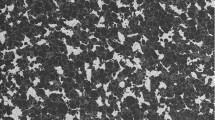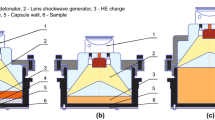Abstract
Results of experiments in which the collision variables were carefully controlled showed that bond zone wave formation during explosion cladding is analogous to the formation of vortex streets in fluid flow around an obstacle or in the collision of liquid streams. The fluid flow analogy explains the observed transition from a smooth metal-to-metal bond zone to a wavy bond zone above a critical collision velocity. This model is capable of predicting the minimum collision velocity necessary for bond zone wave formation in different metal systems and it also predicts correctly the strong dependence of wave size on collision angle. The magnitude of the wave size agrees with that predicted from fluid flow past a flat plate. Two other mechanisms of bond zone wave formation were explored experimentally and found to be invalid.
Similar content being viewed by others
References
G. R. Cowan and A. H. Holtzman:J. Appl. Phys., 1963, vol. 34, pp. 328–39.
A. H. Holtzman and G. R. Cowan:Welding Research Council Bulletin No. 104, April, 1965, American Welding Society, New York.
U.S. Patent 3,137,937.
U.S. Patent 3,233,312.
A. S. Bahrani and B. Crossland:Proc. Inst. Mech. Eng., 1965, vol. 179, p. 264.
A. S. Bahrant and B. Crossland.Proc. Inst. Mech. Eng., 1965–66, vol. 180. Part 31, Paper 22.
E. Schmidtmann, W. Koch and H. Schenk:Arch. Eisenhüttenw., 1965, vol. 36, pp. 667–76.
B. Crossland, A. S. Bahrani, J. D. Williams, and V. Shribman:Welding and Material Fabrication, 1967, vol. 35, pp. 88–94.
J. L. Demaris and A. Pocalyko:Am. Soc. of Tool Manuf. Eng., 1966, ASTME Paper AD66-113.
A. Pocalyko and C. P. Williams,Welding J., 1964, vol. 43, pp. 854–61.
O. R. Bergmann, G. R. Cowan and A. H. Holtzman:Trans. TMS-AIME, 1966, vol. 236, pp. 646–53.
W. Klein:Techn. Mitt Krupp Forsch. Ber., 1965, vol. 23, pp. 1–9.
A. Burkhardt, E. Hornbogen and K. Keller:Z. Metallk., 1967, vol. 58, pp. 410–15.
O. R. Bergmann:Met. Eng. Quart., ASM, 1966, pp. 60–64.
A. S. Bahrani, T. J. Black, and B. Crossland:Proc. Roy. Soc., 1967, vol. A296, pp. 123–36.
G. Birkhoff and E. H. Zarantello:Jets, Wakes, and Cavities, p. 280, Academic Press, New York, 1957.
Modern Developments in Fluid Dynamics, S. Goldstein, ed., Dover Publications, Inc., New York, 1965.
F. H. Harlow and J. E. Fromm:Phys. Fluids, 1964, vol. 7, pp. 1147–56.
G. R. Cowan and A. S. Balchan:Phys. Fluids, 1965, vol. 8, pp. 1817–27.
A. A. Deribas, V. M. Kudinov, and F. I. Matveenkov:FGV/Combustion, Explosions and Shock Wavest, 1967, vol. 3, pp. 561–68 [344–48].
L. Prandt:Essentials in Fluid Dynamics, Haffner Publishing Co., New York, 1944.
A. Goldburg, W. K. Washburn, and B. H. Florsheim,AIAA Jour., 1965, vol. 3, pp. 1332–33.
S. Taneda:J. Phys. Soc. Japan, 1958, vol. 13, pp. 418–25.
Modern Developments in Fluid Dynamics, S. Goldstein, ed., p. 136 Dover Publications, Inc., New York, 1965.
Chemical Engineers' Handbook, 4th Ed., J. H. Perry, ed., p. 5–60, McGraw-Hill, Inc., New York, 1963.
R. Wille: inAdvan. Appl. Mech., vol. VI, p. 281, Academic Press, New York 1960.
Homann, F.:Forsch. Gebiete Ingenieurw., 1936, vol. 7, pp. 1–10.
Author information
Authors and Affiliations
Rights and permissions
About this article
Cite this article
Cowan, G.R., Bergmann, O.R. & Holtzman, A.H. Mechanism of bond zone wave formation in explosion-clad metals. Metall Trans 2, 3145–3155 (1971). https://doi.org/10.1007/BF02814967
Received:
Issue Date:
DOI: https://doi.org/10.1007/BF02814967




